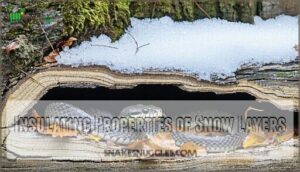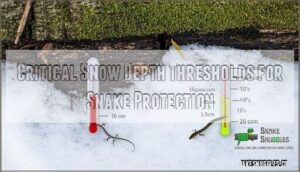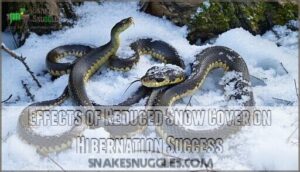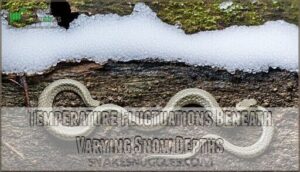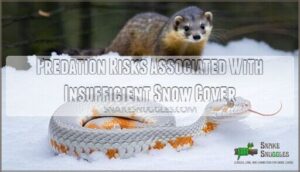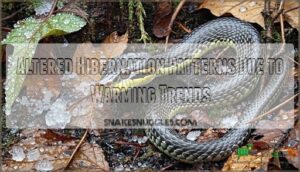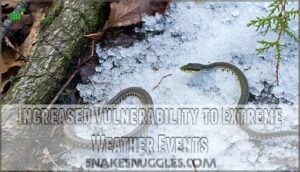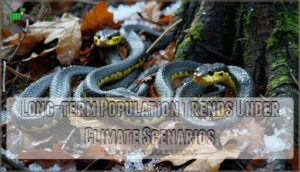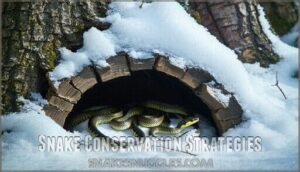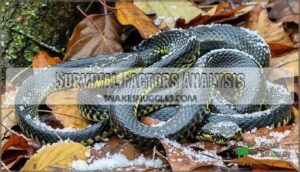This site is supported by our readers. We may earn a commission, at no cost to you, if you purchase through links.
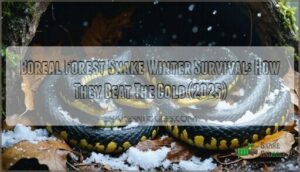 When you’re wondering about boreal forest snake winter survival, you’ll find these reptiles are nature’s ultimate winter warriors.
When you’re wondering about boreal forest snake winter survival, you’ll find these reptiles are nature’s ultimate winter warriors.
They enter brumation—essentially hitting life’s snooze button—where their metabolism drops to nearly zero, heartbeat slows dramatically, and they burn stored fat like a slow-release energy source.
You’ll typically find them huddled together in underground burrows, rock crevices, or beneath thick leaf piles, sharing body heat like cold campers around a dying fire.
The boreal forest’s deep snow acts as their personal insulation blanket, keeping their hideouts just warm enough to prevent freezing.
Their bodies can actually tolerate near-freezing temperatures without turning into reptilian popsicles, thanks to specialized proteins that prevent ice crystal formation in their cells.
What’s truly remarkable is how these survival strategies vary dramatically between different species and even individual snakes.
Table Of Contents
- Key Takeaways
- Snake Winter Survival
- Boreal Forest Ecology
- Climate Change Effects
- Snake Conservation Strategies
- Survival Factors Analysis
- Frequently Asked Questions (FAQs)
- Which snakes can survive in the winter?
- Can a snake freeze in the winter?
- What do Canadian snakes do in the winter?
- Can salamanders survive winter?
- What role do snake predators play in winter?
- How do snakes find hibernation sites?
- What is the frequency of snake hibernation?
- How does diet affect snake winter survival?
- How do snakes thermoregulate during hibernation?
- How do different snake species compare in hibernation duration?
- Conclusion
Key Takeaways
- You’ll need at least 15 centimeters of snow cover – Without this critical depth, your local boreal snakes face under 20% survival rates, but adequate snow boosts their chances above 60% by creating essential insulation.
- Snakes dramatically slow their metabolism to just 1% of summer levels – During brumation, they’ll burn stored fat like a slow-release battery while their heartbeat drops and specialized proteins prevent deadly ice crystal formation in their cells.
- They huddle together in underground hibernacula for warmth – You’ll find dozens of snakes sharing body heat in rock crevices, burrows, or beneath leaf piles, essentially camping together through winter’s harshest months.
- Climate change is disrupting their ancient survival patterns – Warming temperatures are shifting when snakes enter dens, altering their hibernation duration, and creating new challenges that threaten 70% population crashes by 2070.
Snake Winter Survival
When winter temperatures plummet in boreal forests, you might wonder how cold-blooded snakes survive months of freezing conditions without becoming snake popsicles.
These remarkable reptiles have evolved incredible physiological and behavioral adaptations that allow them to enter a state called brumation, dramatically slowing their metabolism and seeking refuge in underground hibernacula where they can weather the harshest winters, utilizing their ability to survive in a state of dramatically slowed metabolism.
Physiological Changes for Hibernation
Your snake’s body undergoes remarkable transformations during winter hibernation.
When temperatures drop below freezing, these cold-blooded masters transform their entire biology to cheat death itself.
Snake metabolic rate drops dramatically, sometimes to just 1% of summer levels, allowing incredible energy conservation.
Snake body temperature matches their surroundings, triggering glucose production for cryoprotection against freezing.
Key physiological changes include:
- Metabolic depression slows all body functions
- Anoxia tolerance enables survival without oxygen
- Calcium buffering neutralizes dangerous acid buildup
- Enhanced glucose acts as natural antifreeze
These adaptations make snake brumation behavior possible in harsh boreal conditions.
Behavioral Strategies for Winter Survival
You’ll watch boreal snakes make smart choices before winter hits.
Den Site Selection involves finding underground hibernacula with stable temperatures, often rocky crevices or mammal burrows below the frost line.
Communal Hibernation brings dozens of snakes together, sharing body heat and reducing individual energy loss.
Pre-Winter Behavior includes feeding heavily and selecting ideal microhabitat locations for thermal refuge protection throughout winter dormancy, which involves stable temperatures and thermal refuge.
Thermal Regulation in Cold Environments
When boreal snakes face frigid winters, they become masters of thermal regulation through sophisticated ectotherm physiology and behavioral thermoregulation strategies.
You’ll find these cold-blooded survivors selecting precise microclimate locations within thermal refuges, where insulation mechanisms like thick snow layers create protective barriers.
Their behavioral thermoregulation involves careful positioning within hibernacula to maximize available metabolic heat, demonstrating remarkable snake cold adaptation for effective energy conservation.
Some species even exhibit genetic diversity benefits that aid in ecological niche exploitation, which is a key aspect of their survival strategy, showcasing their ability to thrive in challenging environments through effective energy conservation and sophisticated ectotherm physiology.
Metabolic Adjustments During Winter Dormancy
During winter’s grip, a snake’s metabolic slowdown becomes its lifeline, dropping to just 1% of summer levels.
This dramatic energy conservation enables snake winter survival through months without food.
When oxygen runs low in hibernacula, snakes develop anoxia tolerance by shifting to glucose production for fuel.
However, this creates acidic waste that threatens survival.
Reptile winter survival depends on acidosis buffering mechanisms, where bones release calcium to neutralize dangerous acid buildup, showcasing remarkable snake cold adaptation and brumation behavior.
Freeze Tolerance and Avoidance Mechanisms
Nature’s survival toolkit includes remarkable freeze tolerance and avoidance mechanisms that keep boreal snakes alive through brutal winters.
When winter freezes everything solid, boreal snakes become nature’s ultimate survival artists.
You’ll find these reptiles using supercooling limits to lower body temperatures without forming deadly ice crystals, while cryoprotectant strategies pump glucose through their systems like biological antifreeze.
However, instant freezing occurs when external ice contacts their supercooled bodies, making the thawing process critical for survival as their cores warm first.
Boreal Forest Ecology
You’ll discover that snow acts like nature’s perfect insulation blanket, creating a protective barrier between freezing air and the underground dens where boreal snakes hibernate.
The deeper the snow gets, the warmer it stays beneath the surface, which means your local garter snakes depend on at least 15 centimeters of snow cover to survive those brutal northern winters, and this dependence is crucial for their survival in the harsh environment with brutal conditions.
Insulating Properties of Snow Layers
Beyond the frozen surface, snow creates nature’s perfect blanket for snake winter survival.
This subnivean environment maintains steady temperatures through snow density variations, protecting snakes in their thermal refuge during boreal hibernation months.
Here’s how snow saves snakes:
- Temperature gradient stability – Snow depth creates consistent warmth beneath, preventing deadly temperature swings
- Energy conservation cocoon – Dense snow layers trap heat, allowing snakes to maintain minimal metabolism without freezing
- Insulation duration protection – Thick snow cover extends throughout winter, providing reliable snake snow cover when they need it most
The deeper the snow, the better the insulation.
Think of it as nature’s sleeping bag – the fluffier and thicker it gets, the warmer you’ll stay underneath.
Critical Snow Depth Thresholds for Snake Protection
Survival’s secret lies in snow depth—you need at least 15 centimeters for snake thermal refuge protection.
Below this threshold, survival probability drops dramatically to under 20%, while adequate snow cover boosts it above 60%.
This critical hibernacula microclimate maintains stable temperatures, decoupling snake winter mortality from harsh air extremes through proper insulation requirements.
Effects of Reduced Snow Cover on Hibernation Success
Reduced snow cover spells trouble for boreal snake hibernation, creating a domino effect of survival challenges.
When Snow Depth Impact drops below critical thresholds, Insulation Loss exposes snake winter dens to deadly temperature swings, causing severe Thermal Stress.
This Climate Vulnerability dramatically increases Hibernation Mortality rates, as your typical snake survival strategy fails without adequate protection from harsh boreal conditions.
A recent study highlights decreased winter survival for grass snakes.
Temperature Fluctuations Beneath Varying Snow Depths
Beneath different snow depth layers, you’ll discover dramatic temperature fluctuations that directly impact boreal snake hibernation success.
When snow depth reaches at least 15 centimeters, insulation effects create stable soil temperature conditions, reducing microclimate variation that threatens snake winter survival.
However, thinner snow cover exposes snake winter den sites to severe temperature fluctuations, dramatically lowering survival rates through compromised snake microhabitat selection, which is critical for their winter survival in stable soil temperature conditions.
Predation Risks Associated With Insufficient Snow Cover
When snow cover drops below 15 centimeters, you’re exposing hibernating snakes to a deadly game of hide-and-seek with winter predators.
Shallow snow creates thermal exposure that forces snakes closer to the surface, where they become sitting ducks for hungry mammals and birds.
One example of a snake that might be vulnerable is the docile snow corn snake.
Predation risks with insufficient snow:
- Predator access increases dramatically through thin snow layers
- Behavioral shifts force snakes into vulnerable surface positions
- Energetic costs rise as snakes must relocate to safer microhabitats
- Mortality rates spike when snake predator avoidance fails during winter survival attempts
Climate Change Effects
You’re witnessing climate change reshape how boreal forest snakes survive winter, with warming temperatures disrupting hibernation patterns that evolved over thousands of years.
These changes affect everything from when snakes enter their dens to where they can successfully overwinter, creating new survival challenges across northern ecosystems.
Altered Hibernation Patterns Due to Warming Trends
You’re witnessing unprecedented changes in boreal snake hibernation behavior as climate change disrupts ancient survival patterns.
Warmer temperatures are shifting emergence timing, shortening hibernation duration, and causing metabolic disruption that increases disease susceptibility.
These altered brumation cycles directly impact reproductive success, as snakes emerge before ideal conditions exist, throwing off their carefully timed breeding schedules, which can be attributed to climate change.
Shifts in Snake Distribution and Range Expansion
Warming temperatures are nudging boreal snakes northward, but you’ll find their geographic range expansion isn’t as straightforward as predictions suggest.
Climate change creates opportunities for northern migration, yet habitat fragmentation and competition often limit actual movement.
Boreal forest snakes face genetic diversity challenges as populations shift, making boreal snake hibernation sites essential for snake winter survival success.
Some species may experience climate-niche shifts impacting their survival.
Changes in Prey Availability and Food Web Dynamics
You’ll notice prey scarcity reshaping food web dynamics as climate change disrupts boreal forest ecosystems.
Warming temperatures shift rodent populations northward, forcing dietary shifts in snake species.
This creates increased competition among predators for limited resources.
Snake energy conservation becomes critical during extended brumation periods when traditional prey becomes unavailable, fundamentally altering predator-prey dynamics and threatening population stability.
Increased Vulnerability to Extreme Weather Events
Climate change brings Weather Variability that catches boreal forest snakes off-guard during hibernation.
Unpredictable Freeze-Thaw Cycles disrupt their carefully timed brumation, forcing snakes from protective hibernacula when temperatures plummet again.
These extreme events cause Habitat Degradation and trigger Population Declines, creating significant Conservation Challenges for maintaining stable snake winter survival rates across changing boreal ecosystems.
Long-term Population Trends Under Climate Scenarios
Beyond extreme weather disruptions, you’ll see boreal forest snake populations facing unprecedented challenges through climate modeling predictions.
Longterm data reveals alarming trends as habitat loss accelerates and genetic diversity shrinks. These population decline patterns show how adaptation limits constrain snake winter survival strategies, making conservation planning critical:
- 70% population crashes predicted by 2070
- Genetic bottlenecks reducing cold tolerance
- Habitat fragmentation isolating hibernacula
- Shortened hibernation periods disrupting reproduction cycles
Climate change fundamentally rewrites survival rules for these remarkable cold-weather specialists.
Habitat restoration becomes essential, as microclimates aid survival.
Snake Conservation Strategies
You’ll find that protecting boreal forest snakes requires targeted conservation efforts that address their unique winter survival challenges.
Effective strategies include habitat management, artificial den creation, population monitoring, policy development, and public education programs.
These programs guarantee that these remarkable cold-adapted species continue to thrive in our changing climate.
Habitat Management for Winter Den Protection
You’ll protect snake hibernacula through strategic Den Site Selection around rocky outcrops and root systems that provide stable microclimates.
Microclimate Management involves preserving natural windbreaks and vegetation that buffer temperature extremes. Snow Management means maintaining adequate cover depth, while Habitat Connectivity guarantees snakes can access multiple winter refugia.
Brumation is essential for their survival. Predator Exclusion focuses on limiting disturbance around critical hibernation sites during snake brumation behavior periods.
Artificial Hibernacula Creation and Maintenance
When natural hibernacula aren’t available, you’ll need to build artificial ones that match snakes’ specific brumation requirements.
Smart hibernacula design incorporates multi-chambered structures descending 1-2 meters deep, reaching groundwater for thermal stability and maintaining temperatures around 2.8°C with 92% humidity.
These structures can be purchased as pre-made snake shelters.
Key construction considerations include:
- Material selection using HDPE pipes, rocks, and natural substrates for proper insulation
- Temperature monitoring systems with removable caps for borescope inspection
- Predator protection through strategic entrance placement and debris barriers
Regular maintenance guarantees long-term viability, as these structures become lifelines for snake winter survival when natural microhabitat selection options disappear.
Monitoring Programs for Population Assessment
You’ll need tracking systems that monitor Population Size trends across multiple hibernacula, documenting which snakes return each spring.
Scientists use mark-recapture techniques to calculate Survival Rates, while radio telemetry reveals Habitat Use patterns and snake microhabitat selection during Boreal forest winters.
Genetic Diversity sampling helps identify vulnerable populations, and systematic surveys enable early Threats Identification for effective snake brumation behavior conservation.
Policy Recommendations for Snake Conservation
Through thorough habitat protection laws, you’ll safeguard critical hibernacula from development and disturbance.
Enforcement strategies must include regular monitoring, hefty penalties for violations, and dedicated wildlife officers.
Research funding enables long-term studies tracking climate change impact on snake winter survival patterns.
Public awareness campaigns build community support for boreal forest conservation initiatives, while climate mitigation policies address warming temperatures threatening these vulnerable reptile populations.
Public Education on Boreal Snake Ecology and Conservation
Challenge common snake misconceptions through educational programs that highlight their ecosystem importance in boreal forest winter survival.
You’ll discover these remarkable creatures aren’t dangerous villains but essential predators managing rodent populations.
Conservation actions flourish when citizen science projects connect communities with snake winter survival strategies, transforming fear into fascination and fostering meaningful conservation efforts.
Survival Factors Analysis
When you’re studying boreal forest snakes, you’ll discover that winter survival depends on several biological factors that determine who makes it through hibernation and who doesn’t.
Your snake’s sex, size, age, body condition before winter, and whether it reproduced that year all play vital roles in determining its chances of surviving those brutal months underground, with hibernation being a critical period.
Differences in Male and Female Winter Survival Rates
Across the Boreal forest, male snake winter survival consistently outpaces females by significant margins.
Sex differences emerge from reproductive costs that drain female energy reserves before hibernation, while males maintain better body composition.
Hormonal influence affects metabolic efficiency during dormancy, creating survival disparities that persist despite similar forest snake freeze tolerance mechanisms and snake energy conservation strategies under snake climate change impact.
Body Size Influence on Cold Tolerance
Sizing up your snake’s winter odds reveals fascinating physics at work.
Larger snakes enjoy better cold tolerance through improved supercooling abilities and enhanced insulation efficiency, while smaller individuals face greater surface area challenges that affect their metabolic rate during boreal forest hibernation.
- Size and Supercooling: Bigger bodies maintain stable temperatures longer
- Surface Area: Smaller snakes lose heat faster through proportionally larger skin exposure
- Fat Reserves: Larger snakes store more energy for extended winter survival
- Metabolic Rate: Size directly influences energy consumption during cold adaptation
Age-related Survival Probabilities During Hibernation
Surprisingly, young snakes often face higher Juvenile Mortality rates during their first winter hibernation, while experienced adults demonstrate better survival probability.
Overwintering Experience becomes essential, as older snakes develop refined site selection skills that reduce mortality rate.
| Age Group | Winter Survival Rate |
|---|---|
| Juveniles (0-1 years) | 65-75% |
| Young Adults (2-4 years) | 80-85% |
| Mature Adults (5-10 years) | 85-90% |
| Elderly (10+ years) | 75-80% |
Senescence Effects eventually impact Adult Longevity, creating a U-shaped survival curve where both very young and very old snakes show increased vulnerability during hibernation.
Impact of Pre-winter Body Condition on Survival
A snake’s pre-winter body condition acts like a bank account—those with bigger Fat Reserves and better Hydration Levels survive longer hibernation periods.
Well-nourished snakes with ideal Muscle Mass enter winter with lower mortality rates, while those carrying high Toxin Load face reduced survival probability during extended dormancy.
Key Body Condition Factors:
- Fat Reserves – Snakes need 15-20% body fat to fuel 6-month hibernation periods without feeding
- Hydration Levels – Proper water balance prevents cellular damage during metabolic slowdown phases
- Muscle Mass – Lean muscle provides emergency protein when fat stores become depleted
- Gut Microbiome – Healthy bacteria populations support immune function throughout winter dormancy
Reproductive Status Effects on Winter Mortality
Pregnant females face the ultimate winter gamble when mating season happens too close to hibernation.
You’ll find that egg-laying burden dramatically increases winter mortality rates, as reproductive cost drains energy reserves needed for survival.
Gestation impact means females carrying developing clutches can’t build fat stores effectively.
Clutch size directly correlates with death rates—larger clutches equal higher risks, making reproductive cost and winter mortality critical factors.
Snake reproduction timing becomes a life-or-death decision in boreal forests.
Frequently Asked Questions (FAQs)
Which snakes can survive in the winter?
Most boreal forest snakes can’t actually survive freezing – they’re considered freeze-intolerant and typically die after a couple days below 0°C.
However, garter snakes can supercool to -5°C and survive being frozen for about ten hours.
Can a snake freeze in the winter?
Yes, you’ll find that snakes can freeze during winter, though most avoid this fate through clever adaptations.
Supercooling lets them survive brief cold snaps, while freeze-tolerant species like gartersnakes endure limited freezing periods before fatal consequences occur.
What do Canadian snakes do in the winter?
Like hibernating bears retreating to caves, you’ll find Canadian snakes gathering in underground dens called hibernacula during winter.
They enter brumation, dramatically slowing their metabolism to survive months without food in frozen ground.
Can salamanders survive winter?
You’ll discover salamanders have impressive winter survival skills. Some species, like Jefferson salamanders, actively migrate and breed under snow and ice. Meanwhile, mudpuppies stay active all winter long.
What role do snake predators play in winter?
During winter, you’ll find snake predators become largely inactive too, since most are also ectothermic and enter hibernation, creating a relatively safe dormant period for overwintering snakes.
How do snakes find hibernation sites?
Beneath frozen ground lies their secret—snakes don’t randomly stumble upon winter hideouts.
You’ll find they return to the same hibernacula year after year, demonstrating remarkable site fidelity and using environmental cues to locate these underground sanctuaries.
What is the frequency of snake hibernation?
Snakes hibernate annually, entering brumation each winter when temperatures drop below their activity threshold.
You’ll find they remain dormant for roughly four to six months, emerging only when spring warmth returns to their habitat, which is a period of dormancy.
How does diet affect snake winter survival?
You’ll find that pre-winter feeding doesn’t directly impact survival once snakes enter brumation, since their drastically reduced metabolism means they’re virtually fasting throughout winter hibernation regardless.
How do snakes thermoregulate during hibernation?
Like dormant bears retreating to winter dens, you’ll find snakes dramatically slow their metabolism during hibernation, reducing it to minimal levels.
They can’t generate heat, so they rely on underground hibernacula‘s stable temperatures for survival.
How do different snake species compare in hibernation duration?
You’ll discover hibernation duration varies dramatically between snake species.
Garter snakes typically brumate for 4-6 months, while some boreal species can remain dormant for up to 8 months depending on local climate conditions.
Conclusion
Understanding boreal forest snake winter survival reveals nature’s remarkable engineering at work.
These resilient reptiles demonstrate that survival isn’t just about brute strength, but intelligent adaptation.
Through brumation, communal denning, and specialized freeze-protection proteins, they’ve mastered winter’s harsh demands.
As climate change reshapes their world, protecting these cold-weather champions becomes increasingly important.
Their survival strategies offer valuable insights into resilience, reminding us that even the seemingly vulnerable can thrive against impossible odds through evolutionary innovation.
- https://wildlifepreservation.ca/blog/how-snakes-overwinter/
- https://uphere.ca/articles/snakes-plains
- https://gohikevirginia.com/where-do-snakes-go-in-the-winter/
- https://bioone.org/journals/journal-of-herpetology/volume-54/issue-2/18-143/A-Long-Term-Study-on-Massasaugas-Sistrurus-catenatus-Inhabiting-a/10.1670/18-143.full
- https://www.oriannesociety.org/faces-of-the-forest/enduring-and-avoiding-the-cold-how-reptiles-and-amphibians-survive-northern-winters/

